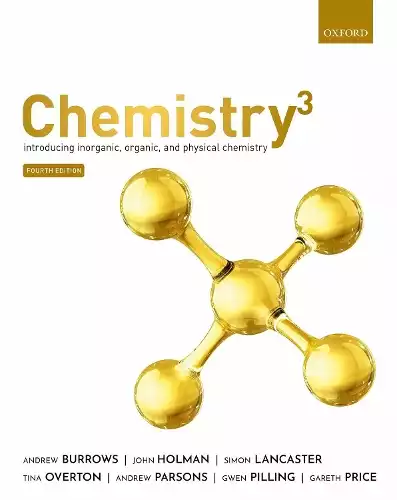
Save: 20%

Save: 0%
Chemistry 3 4E
Publisher:
| Author:
| Language:
| Format:
Publisher:
Author:
Language:
Format:
₹2,670 ₹2,136
Save: 20%
In stock
Ships within:
In stock
| Weight | 2800 g |
|---|---|
| Book Type |
ISBN:
Page Extent:
Chemistry is widely considered to be the central science: it encompasses concepts on which all other branches of science are developed. Yet, for many students entering university, gaining a firm grounding in chemistry is a real challenge. Chemistry³ responds to this challenge, providing students with a full understanding of the fundamental principles of chemistry on which to build later studies. Uniquely amongst the introductory chemistry texts currently available, Chemistry³’s author team brings together experts in each of organic, inorganic, and physical chemistry with specialists in chemistry education to provide balanced coverage of the fundamentals of chemistry in a way that students both enjoy and understand. The result is a text that builds on what students know already from school and tackles their misunderstandings and misconceptions, thereby providing a seamless transition from school to undergraduate study. Written with unrivalled clarity, students are encouraged to engage with the text and appreciate the central role that chemistry plays in our lives through the unique use of real-world context and photographs. Chemistry³ tackles head-on two issues pervading chemistry education: students’ mathematical skills, and their ability to see the subject as a single, unified discipline. Instead of avoiding the maths, Chemistry³ provides structured support, in the form of careful explanations, reminders of key mathematical concepts, step-by-step calculations in worked examples, and a Maths Toolkit, to help students get to grips with the essential mathematical element of chemistry. Frequent cross-references highlight the connections between each strand of chemistry and explain the relationship between the topics, so students can develop an understanding of the subject as a whole. Digital formats and resources Chemistry³ is available for students and institutions to purchase in a variety of formats, and is supported by online resources. The e-book offers a mobile experience and convenient access along with functionality tools, navigation features, and links that offer extra learning support: www.oxfordtextbooks.co.uk/ebooks The e-book also features interactive animations of molecular structures, screencasts in which authors talk step-by-step through selected examples and key reaction mechanisms, and self-assessment activities for each chapter. The accompanying online resources will also include, for students: · Chapter 1 as an open-access PDF; · Chapter summaries and key equations to download, to support revision; · Worked solutions to the questions in the book. The following online resources are also provided for lecturers: · Test bank of ready-made assessments for each chapter with which to test your students · Problem-solving workshop activities for each chapter for you to use in class · Case-studies showing how instructors are successfully using Chemistry3 in digital learning environments and to support innovative teaching practices · Figures and tables from the book
Chemistry is widely considered to be the central science: it encompasses concepts on which all other branches of science are developed. Yet, for many students entering university, gaining a firm grounding in chemistry is a real challenge. Chemistry³ responds to this challenge, providing students with a full understanding of the fundamental principles of chemistry on which to build later studies. Uniquely amongst the introductory chemistry texts currently available, Chemistry³’s author team brings together experts in each of organic, inorganic, and physical chemistry with specialists in chemistry education to provide balanced coverage of the fundamentals of chemistry in a way that students both enjoy and understand. The result is a text that builds on what students know already from school and tackles their misunderstandings and misconceptions, thereby providing a seamless transition from school to undergraduate study. Written with unrivalled clarity, students are encouraged to engage with the text and appreciate the central role that chemistry plays in our lives through the unique use of real-world context and photographs. Chemistry³ tackles head-on two issues pervading chemistry education: students’ mathematical skills, and their ability to see the subject as a single, unified discipline. Instead of avoiding the maths, Chemistry³ provides structured support, in the form of careful explanations, reminders of key mathematical concepts, step-by-step calculations in worked examples, and a Maths Toolkit, to help students get to grips with the essential mathematical element of chemistry. Frequent cross-references highlight the connections between each strand of chemistry and explain the relationship between the topics, so students can develop an understanding of the subject as a whole. Digital formats and resources Chemistry³ is available for students and institutions to purchase in a variety of formats, and is supported by online resources. The e-book offers a mobile experience and convenient access along with functionality tools, navigation features, and links that offer extra learning support: www.oxfordtextbooks.co.uk/ebooks The e-book also features interactive animations of molecular structures, screencasts in which authors talk step-by-step through selected examples and key reaction mechanisms, and self-assessment activities for each chapter. The accompanying online resources will also include, for students: · Chapter 1 as an open-access PDF; · Chapter summaries and key equations to download, to support revision; · Worked solutions to the questions in the book. The following online resources are also provided for lecturers: · Test bank of ready-made assessments for each chapter with which to test your students · Problem-solving workshop activities for each chapter for you to use in class · Case-studies showing how instructors are successfully using Chemistry3 in digital learning environments and to support innovative teaching practices · Figures and tables from the book
About Author
Reviews
There are no reviews yet.



Reviews
There are no reviews yet.